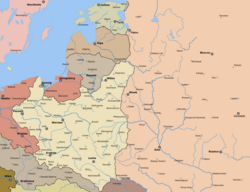| Revision as of 01:38, 27 May 2007 editPetri Krohn (talk | contribs)Autopatrolled, Extended confirmed users37,094 edits →See also: + Commune of the Working People of Estonia← Previous edit | Revision as of 01:52, 27 May 2007 edit undoNug (talk | contribs)Autopatrolled, Extended confirmed users, Pending changes reviewers22,427 edits Nominated for deletion: see Misplaced Pages:Articles for deletion/Estonia (1917-1918)Next edit → | ||
| Line 1: | Line 1: | ||
| <!-- Please do not remove or change this AfD message until the issue is settled --> | |||
| {{AfDM|{{{1|Estonia (1917-1918)}}}|Estonia_%281917-1918%29|{{SERVER}}|2007|May|27}} | |||
| <!-- End of AfD message, feel free to edit beyond this point --> | |||
| {{Infobox Former Country | {{Infobox Former Country | ||
| |native_name = Eestimaa | |native_name = Eestimaa | ||
Revision as of 01:52, 27 May 2007
| An editor has nominated this article for deletion. You are welcome to participate in the deletion discussion, which will decide whether or not to retain it.Feel free to improve the article, but do not remove this notice before the discussion is closed. For more information, see the guide to deletion. Find sources: "Autonomous Governorate of Estonia" – news · newspapers · books · scholar · JSTOR%5B%5BWikipedia%3AArticles+for+deletion%2FAutonomous+Governorate+of+Estonia%5D%5DAFD Steps to list an article for deletion:
Unregistered users placing this tag on an article cannot complete the deletion nomination and should leave detailed reasons for deletion on Talk:Autonomous Governorate of Estonia and then post a message at Misplaced Pages talk:Articles for deletion requesting that someone else complete the process. If the nomination is not completed and no message is left on the talkpage, this tag may be removed. |
| EstlandEestimaa | |||||||||
|---|---|---|---|---|---|---|---|---|---|
| 1917–1918 | |||||||||
| Flag of Estland Flag Coat of arms of Estland Coat of arms | |||||||||
 Estland was located approximately on the later territory of Estonia (above, green), declarated February 23, 1918. Estland was located approximately on the later territory of Estonia (above, green), declarated February 23, 1918. | |||||||||
| Capital | Tallinna | ||||||||
| Common languages | Estonian Low German | ||||||||
| Government | Republic | ||||||||
| Chairman of the Executive Committee of the Soviets of Estland (Eestimaa Nõukogude Täitevkomitee esimees) | |||||||||
| • 5 November (23 October) 1917 - 4 March 1918 | Jaan Anwelt | ||||||||
| Land Councillor (Maanõunik) | |||||||||
| • 28 November (15 November) 1917 - 24 February 1918 | Jaan Poska | ||||||||
| Legislature | Maapäev | ||||||||
| History | |||||||||
| • Established | November 28, 1917 (de jure) November 5, 1917 (de facto) 1917 | ||||||||
| • Disestablished | February 24, 1918 (de jure) March 4, 1918 (de facto) 1918 | ||||||||
| Currency | Russian ruble of the Russian Provisional Government | ||||||||
| |||||||||
Estonia (also Estland, Template:Lang-et, Low German: Ehstland, Template:Lang-ru )as an unified and separate political entity first emerged as a result of the Russian Revolution of 1917. For most of its history, Estonia was divided between two states or provinces. The Reval Governorate in the north corresponded to the historic Estland (Eestimaa). Most Estonians however lived in Livonia. After the February Revolution of 1917 the Reval Governorate was extended on April 12 (March 30 Old Style) to include the native Estonian ares of northern Livonia. Elections for provinsional parliament, Maapäev was organized, with the Menshevik and Bolshevik fractions of the Russian Social Democratic Labour Party becoming the largest parties. On November 5, 1917, two days before the October Revolution in Saint Petersburg, Estonian Bolshevik leader Jaan Anwelt led his leftist revolutionaries to the revolution in Tallinn, then the capital of Estland, and took the political power. In November 7 (October 25), 1917. On November 28 (November 15) 1917 the Menshevik dominated Maapäev, refusing to recognize the new Bolshevik rule, proclaimed itself the supreme legal authority of Estland. It was soon however disbanded by the the Bolsheviks. In 1918 elections for a Constitutional Assembly were arranged, anti-Bolshevik parties again winning the majority.
In Febryary, after the collapse of the peace talks between the Soviet Russia and the German Empire Estonia was occupied by Germans. Bolshevik forces retrated to Russia. On 23 February 1918, one day before German forces entered Tallinn, the Elders of the Maapäev emerged from underground and made a formal declaration of independence of the Republic of Estonia. Although it took and almost a year for Estonia to be liberated from German occupation, this data is still selebrated as Estonia's independence day.
See also
External links
- Jaan Anwelt
- Tartu rahu sepistaja Jaan Poska väärib monumenti (Estonian)
- On 28 November 1917, the Estonian Diet (the Maapäev) declared itself fee supreme power in Estonia.
- On 28 November 1917, the Land council proclaimed itself the highest power in Estonia...
- On This Day - 28 November 1917
- Though the popularly elected Provisional National Council, had proclaimed itself the highest authority in Estonia as early as 28 November 1917...